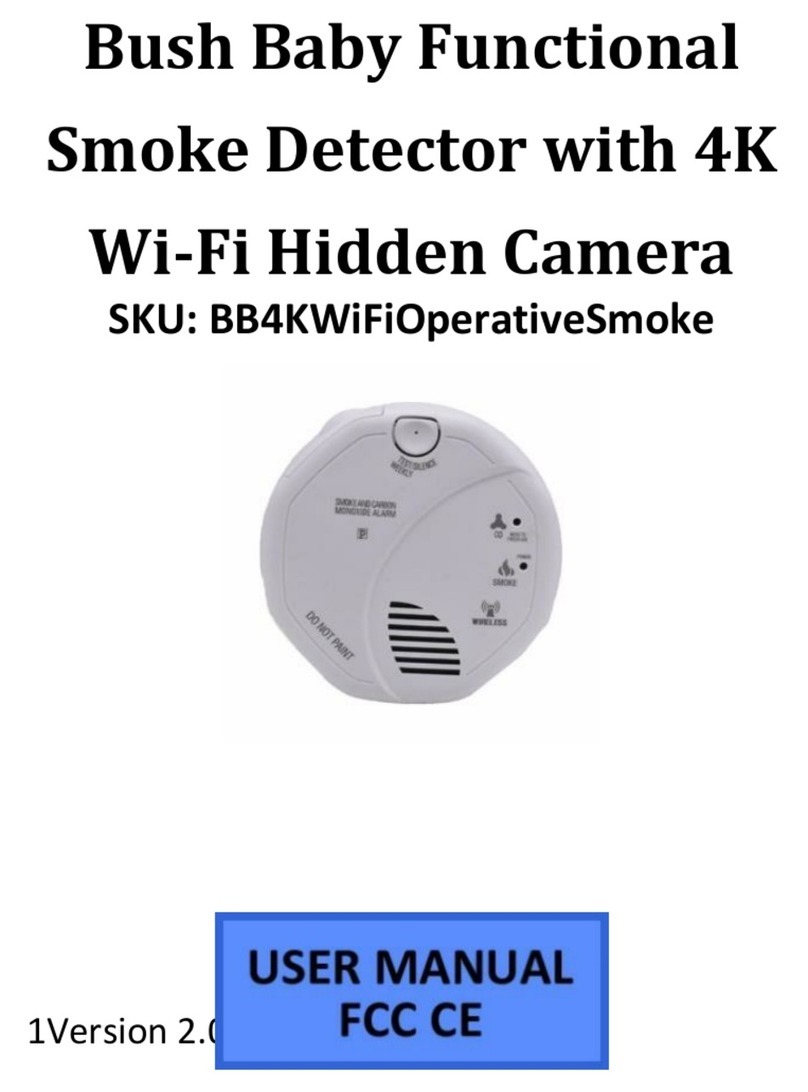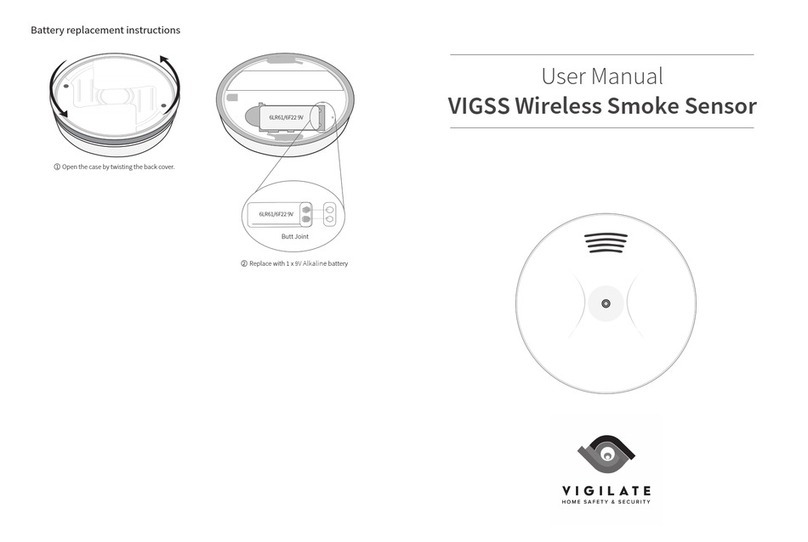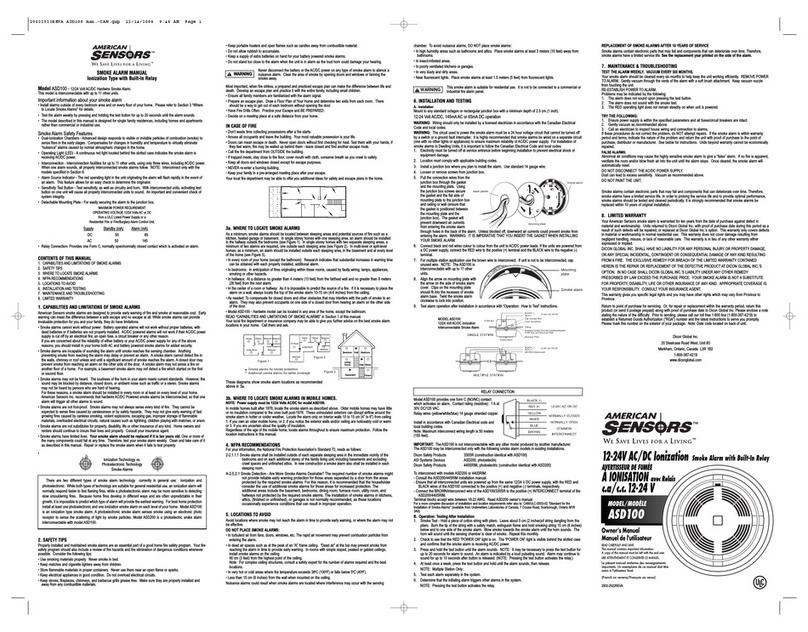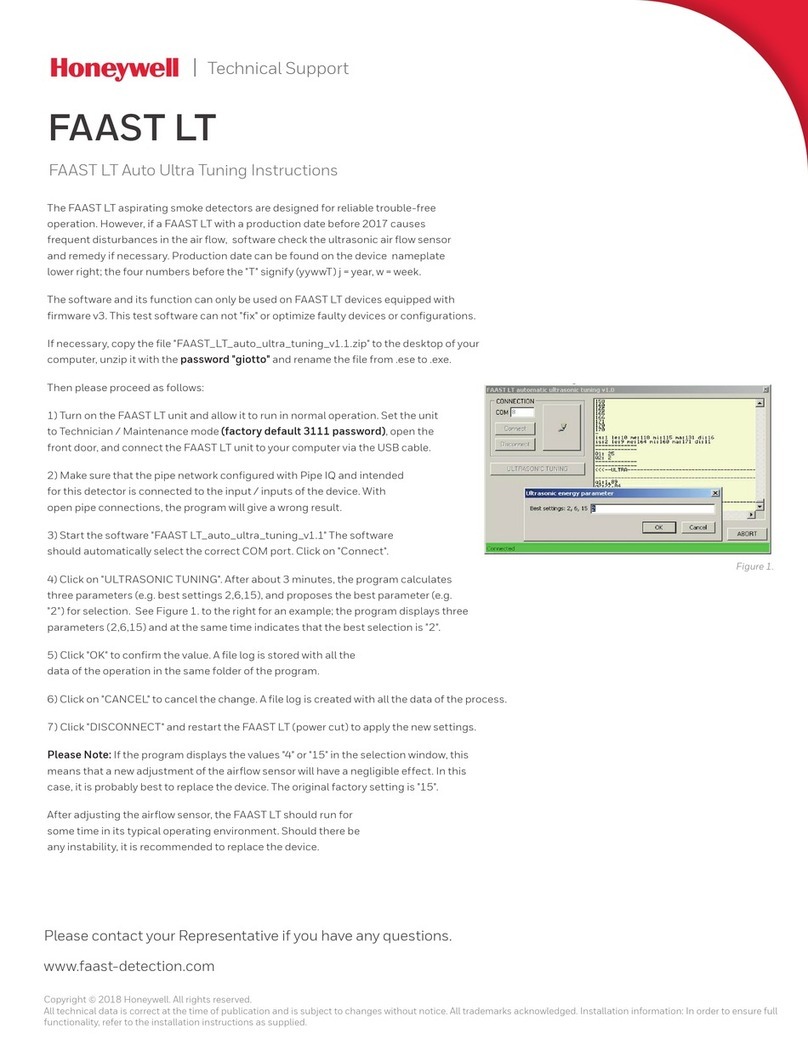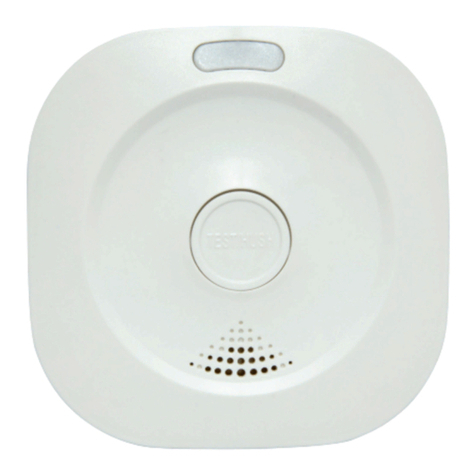Bascom_turner OM-1108 User manual

BASCOM-TURNER
INSTRUMENTS
GAS-RANGER
DETECTORS
OPERATION MANUAL
NATURAL GAS, CARBON MONOXIDE, OXYGEN,
AND HYDROGEN SULFIDE DETECTORS
Part Number OM-1108


LIMITED WARRANTY
Bascom-Turner Instruments warrants Gas-Ranger Detectors to be free from defects in
materials and workmanship for one year following the date of shipment. This limited
warranty applies to the original purchaser of the Detector and is not transferable except
by Bascom-Turner's authorized Distributors.
The instruments described in this manual are produced with standard commercial parts,
any of which may fail under some circumstances. Although the probability of such
failure is low, it is not zero. Accordingly, all personnel using such instruments must be
trained to recognize instrument malfunctions and to have such instruments repaired
promptly. Bascom-Turner offers no warranty that failures will not occur – only that
when they occur, they will be promptly cured with the following procedure:
During the limited warranty period, we will repair or replace, at our option, any
defective products or parts at no additional charge. A return merchandise authorization
(RMA) number must be obtained prior to returning a detector to Bascom-Turner. A
detector returned to Bascom-Turner with probe and water-block filter, shipping
prepaid, will be repaired, calibrated and returned second day air. Warranty repairs do
not include pump cleaning, filter replacement and calibration. All replaced parts and
products become the property of Bascom-Turner Instruments.
This limited warranty does NOT extend to any Detectors which have been damaged as a
result of accident, abuse, modification, misuse, such as failure to follow the operating
instructions provided by Bascom-Turner Instruments, or other contingencies beyond
our control. No other warranty is expressed or implied. Bascom-Turner is not liable for
consequential damages.
CAUTION
Personnel who operate, calibrate, or repair t
his instrument must first read and fully
understand this manual in its entirety.
For use in Class I, Division 1, Groups A, B, C and D atmospheres.
This product has not been tested for intrinsic safety in oxygen enriched atmospheres.
Change batteries and service detectors only in non-hazardous locations.


i
TABLE OF CONTENTS
SPECIFICATIONS
FEATURES
PART 1. OPERATION
1. The Gas-Ranger Detectors ...................................................................................... 1
2. Operation................................................................................................................. 2
3. Instrument Checks................................................................................................... 8
4. Interference from Other Gases, Liquids, or RFI ..................................................... 9
5. Change of Batteries................................................................................................. 10
6. Troubleshooting ...................................................................................................... 11
7. Probes...................................................................................................................... 12
8. Routine Maintenance .............................................................................................. 13
PART 2. CALIBRATION AND ALARM LEVEL SELECTION
9. Automatic Calibration with A-CAL
TM
................................................................... 15
10. Alarm Level Selection ............................................................................................ 18
11. Manual Calibration, Sensor Replacement, Pump Adjustment................................ 22
APPENDIX I Set Up and Purge of the Calibration Gas Dispenser ............................. 29
APPENDIX II Set Up of the Manual Calibration Apparatus........................................ 31
ACCESSORIES AND SPARE PARTS .......................................................................... 33

iii
FEATURES
The Gas-Rangerportable methane, and combined methane, carbon monoxide,
hydrogen sulfide and oxygen detectors are intrinsically safe, microprocessor based instruments
designed to test ambient air and flue gas over a wide temperature range.
These detectors have many features for easy and reliable operation:
•Measurements Over the Full Range of Gas
The instruments detect methane over the full range of methane concentrations.
•TRACK GAS Scale
A sensitive scale with quick response makes it easy to find gas leaks.
•Automatic Zero
Automatic zero adjustment without knobs to turn or buttons to press.
•Automatic Calibration
Calibration is performed automatically using Bascom-Turner's calibration gas.
•Automatic Sampling
An intrinsically safe, high speed pump automatically samples ambient air or flue gas.
No need to "purge" on changing operating mode or scale.
•Automatic Self-Tests
Automatic checks of battery, sensors, and pump. Tests for blockage and for tight
connection of probe to instrument.
•Bar Holing
Peak and sustained bar-hole readings automatically displayed after gas is pumped for
a precise, fixed time.
•Audible and Visual Alarms
Audible and visual alarms on each scale that can be individually set.
Background monitoring of natural gas, CO, O
2,
and hydrogen sulfide.
•Easy-to-Use
One selector switch sets the mode and scale. No complicated or confusing displays.
•Easy-to-Read, Bright Display
A bright, efficient LED display readable at twenty feet is easy to use both indoors and
outdoors.
•A Water-block Filter
A special Teflonfilter keeps water out even if the probe is fully immersed in water.
•A Tough Package
Housed in a high impact Xenoy alloy, the instruments weigh only about three pounds.

SPECIFICATIONS
(1,2)
Gases
Detected
Natural Gas (Methane)
Carbon Monoxide (CO)
Oxygen (O
2
)
Hydrogen Sulfide (H
2
S)
Sensors
Catalytic Combustion (CH
4
)
Thermal Conductivity (CH
4
)
Electrochemical (CO)
Electrochemical (O
2
)
Electrochemical (H
2
S)
Ranges
% GAS
0 to 100% by volume of methane in steps of
0.05% up to 4.0% and steps of 1% from 4 to
100%.
% LEL 0 to 100% LEL of methane in steps of 1%.
ii
PPM CO 0 to 5000 ppm of carbon monoxide in steps
of 1 ppm.
PPM H
2
S 0 to 1000 ppm of hydrogen sulfide in steps
of 1 ppm.
% O
2
0 to 40% by volume in steps of 0.1%
Accuracy
(5
o
to 45
o
C)
±2% LEL for % LEL scale
±2% GAS for % GAS scale
±5% of reading, ±10 ppm for PPM CO scale
(±10% from 1000 ppm to 5000 ppm)
±5% of reading, ±10 ppm for PPM H
2
S scale
±5% of reading for % oxygen
Warm-Up Time 30 seconds
Operating Temperature
(with fresh batteries)
-30
o
C to 50
o
C
(-20
o
F to 120
o
F)
Maximum Temperature
of Sampled Gas
325
o
C (620
o
F)
Storage Temperature -40
o
C to 60
o
C
(-40
o
F to 140
o
F)
Continuous Operating
Time per Battery Set
12 hours typical (25
o
C)
Humidity 0 to 98% RH
(non-condensing)
Power Supply Two D-size Alkaline
or Rechargeable
Dimensions
Weight
Length 7.80" (19.8 cm)
Width 4.25" (10.8 cm)
Height 4.00" (10.2 cm)
3.20 lb. (1.45 kg)
(1) Not all instruments detect all gases. For a list of detectors
see page 1.
(2) Specifications are applicable to properly calibrated
instruments, see page 2.


1
PART 1. OPERATION
1. THE GAS-RANGER DETECTORS
This manual describes the operation of the family of Gas-Ranger detectors for natural gas,
carbon monoxide and oxygen:
Model RGI -201 - Detects natural gas and displays it as % LEL or % GAS
Model RGI -211 - Detects natural gas and displays it as % GAS
Model RGC-301 - Detects natural gas and carbon monoxide and displays % LEL or
% GAS and PPM CO (parts per million of CO)
Model RGC-311 - Detects natural gas and carbon monoxide and displays % GAS and
PPM CO (parts per million of CO)
Model RGO-321 - Detects natural gas and oxygen and displays % LEL or % GAS and
% Oxygen.
Model RGA-411 - Detects natural gas, CO, and oxygen and displays % GAS, PPM
CO and % Oxygen with TRACK GAS in % LEL
Model RGA-412 - Detects natural gas, CO, and oxygen and displays % GAS, PPM
CO and % Oxygen with TRACK GAS in % GAS.
Model RGA-611 - Detects natural gas, CO, oxygen and H
2
S and displays % GAS,
PPM CO, % Oxygen and PPM H
2
S with TRACK GAS in % LEL
Model RGA-612 - Detects natural gas, CO, oxygen and H
2
S and displays % GAS,
PPM CO, % Oxygen and PPM H
2
S with TRACK GAS in % GAS.
All models detect natural gas and may be used to test ambient air for natural gas, bar hole,
and track gas leaks in pipes and other conduits.
All models which detect carbon monoxide (CO) may be used to test for CO in ambient air
and test for CO in flue gas and gases given off by appliances.
All models have a TRACK GAS scale which operates as follows:
TRACK GAS - Displays the concentration of natural gas in % LEL (Models RGI-
201, RGC-301, RGA-411 and RGA-611) or % GAS (Models RGI-
211, RGC-311, RGA-412 and RGA-612) and operates a beeper for
tracking the source of a leak
All gases detected by a particular instrument are monitored continuously while
using any choice of display, including TRACK GAS.
A unit alerts the user visually and audibly (with an alarm) when the concentration of one
or more gases exceeds preset limits. Alarm limits can be set by the user. Factory set limits are:
% GAS = 1.0% equivalent to % LEL = 20%
PPM CO = 200 ppm
% OXYGEN = 19.5% for low and 23.0% for high
PPM H
2
S = 10 ppm
In the "TRACK GAS" mode, the frequency of a beeper depends on the natural gas
concentration. The beeper is silent below 0.2% LEL (0.04% GAS) and sounds once every 2
seconds at 0.2% LEL of gas, speeds up with rising concentration and is on continuously at 2%
LEL (0.1% gas) above ambient.

2
2. OPERATION
A. Overview of Essential Operating Practice
Gas-Ranger detectors are easy to use. Once the appropriate display is selected, operation
is automatic. However, a few general rules must be followed to insure reliability and accuracy.
Pump. Gas-Ranger detectors have a built-in pump and depend on this pump for their
operation. If the pump is not functioning normally, the instrument will not function properly. It
is therefore essential to check the pump each time the instrument is first turned on.
Pump Test: Connect the probe you plan to use and select any scale. When the
display shows a number, normally zero, block the probe tip with your finger until the display
shows "bloc".
If "bloc" does not appear, there may be a leak along the probe. Tighten all connections
and repeat the test. If a block condition is still not observed, remove the hose and block directly
the inlet to the instrument. If "bloc" still does not appear, call the factory or return the instrument
to the factory for repair.
WARNING: The instrument should never be used when "bloc" fails to appear upon
blocking the inlet.
Filters. Dust and water-block filters protect the sensors and the pump from dust and
accidental intake of liquid water. Just as a car would not be operated without air and fuel filters,
do not operate a Gas-Ranger detector without a filter on the hose. Operation without this filter
will eventually degrade the pump. It also voids the limited warranty.
From time to time, examine the water-block filter on the hose. If loose dirt has
accumulated, shake it out. Do not poke at the filter with a tool or any other implement which
may puncture it. If the filter is substantially discolored by dirt, replace it.
Zero Check. All sensors drift to some extent over time. Sensor drift is corrected by
using the AUTO ZERO position (see Section 3, Instrument Checks). Zeroing takes about 60
seconds and is normally required no more frequently than once a day. It is important that the
zero adjustment be done in clean air, for example, outdoors. If the sampled gas is not clean, a
systematic error will be introduced in all subsequent measurements.
WARNING: On a gas call, use the AUTO
ZERO adjustment outdoors, never indoors.
Zero adjustments must be carried out with clean air.
Test and Calibration. Gas-Ranger detectors must be checked and calibrated
periodically with gas of known composition. The catalytic combustion, carbon monoxide, and
hydrogen sulfide sensors depend on catalysts which may loose activity or get poisoned during
use. When this happens, there will be diminished response.
The necessary frequency of calibration depends on actual use and on the concentration of
catalyst poisons in the sampled gas. This concentration is, or course, not generally known.
A detector can be tested with "bump" gas. Such tests verify that the gas sensor(s) are in
operating condition. To verify and adjust, if necessary, their sensitivity they must be calibrated.
A detector can be automatically calibrated in approximately one minute using Bascom-
Turner's calibration gas (2.5% CH
4
and 100 ppm CO in air). Given the ease and speed of

3
automatic calibration, it pays to calibrate as frequently as possible, and certainly, no less than
monthly.
Accuracy. A properly operating and calibrated detector will respond with the specified
accuracy. If combustible gases other than the gas used for calibration are likely or suspected, the
instrument cannot be relied upon to give a proper indication of their concentration and hence of
how close to their combustible limits they may be. For example, the detector responds quite
differently to gasoline, to methane, and to propane. Accordingly, readings of % LEL (or its
equivalent in percent gas) refer only to the calibration gas and can be relied upon only in this
respect in assessing an atmosphere sampled by the detector. Furthermore, concentrations
displayed by the detector refer to a local sample at the tip of the instrument probe. Low gas
concentrations at one spot do not necessarily mean that the gas concentration is low throughout a
wider area.
Note: All gases detected by a particular instrument are monitored continuously
while using any choice of display.
WARNING: Each detector responds to the gases for which it was designed. Other
toxic or dangerous gases may not be detected.
B. Operational Description
To conserve the batteries, the selector switch should be in the "OFF" position when the
instrument is not in use.
To Use the % GAS Display. Connect an appropriate probe to the water-block filter
attached to the hose and turn selector switch to position marked "% GAS". The display shows
"GAS" for about 15 seconds.
•After warm-up, the display shows the concentration of natural gas in air in percent by
volume (% GAS). If the air is clean (contains no gas), the display should read zero.
If it does not, switch to position marked "AUTO ZERO". After automatic adjustment
of zero is complete (display shows "End"), return the switch to the "% GAS" position.
The % GAS scale spans the whole range of gas in steps of 0.05% from zero to 4.0%
and in steps of 1% from 4 to 100%.
Bar Holing. The detectors may be used to measure gas levels in sampling holes used for
locating underground natural gas resulting from seepage or leaks in a conduit. Gas
concentrations in a bar hole near a significant leak will exceed several percent. Therefore an
alarm for gas is likely, but it has no relevance to the ambient atmosphere above ground. During
bar-holing, the alarm for the % GAS scale is automatically turned OFF.
To bar hole, select an appropriate probe (see Section 7), set the front panel switch to %
GAS and, after a number appears on the display (typically zero), press the RESET switch on the
front panel. The pump is turned off, the display shows "go" and the instrument beeps - it is ready
for bar holing. After inserting the probe into the bar hole, press the RESET switch again. The
pump is turned on and the instrument samples gas for a fixed time (factory set time is 15
seconds). Readings during sampling are shown on the display. At the end of the fixed time for
sampling, the instrument beeps, turns off the pump, and displays the peak (left side of display)
and the sustained (right side of the display) readings. Both values are in % GAS. The instrument
can be returned to the standard display by pressing the RESET switch again.

4
If a check is to be made for trace amounts of gas in a bar hole or above ground, for
example around the foundation of a structure, the % GAS or % LEL display should be used. The
bar holing feature using the RESET switch is appropriate for pinpointing underground leaks.
To Use the % LEL Scale. Connect an appropriate probe to the water-block filter
attached to the hose and turn selector switch to position marked "% LEL". The display shows
"LEL" for about 15 seconds.
*After warm-up, the concentration of natural gas in air is displayed as percent of the
lower flammable limit (LEL). If the air is clean (contains no gas), the display should
read zero. If it does not, switch to position marked "AUTO ZERO". After the display
shows "End", return the switch to the % LEL position.
*The % LEL scale ranges from 0 to 100 % in steps of 1%. The following table shows
equivalent readings in % LEL and % GAS (percent volume):
EQUIVALENT READINGS IN % LEL AND % GAS
% LEL % GAS
0.6 equivalent to 0.03
1 0.05
2 0.1
10 0.5
20 1.0
100 5.0
To Detect Gas and Track Its Source with the TRACK GAS Display. Connect an
appropriate probe to the water-block filter attached to the hose and turn selector switch to
position marked "TRACK GAS". The display shows "SniF" (sniff) for about 25 seconds.
*After warm-up, the display shows the concentration of gas in air in % LEL with the
RGI-201, RGC-301, RGO-321, RGA-411 and RGA-611 and % GAS with the RGI-
211, RGC-311, RGA-412 and RGA-612. If the air is clean (contains no gas), the
display should read zero. If it does not, switch to position marked "AUTO ZERO".
After automatic adjustment of zero is complete, return the switch to the "TRACK
GAS" position.
•Advance a probe along the pipe or other conduit suspected of having a gas leak. The
beeper will sound once every 2 seconds at 0.2% LEL (0.04% GAS) concentrations of
gas, will speed up with rising concentration, and will beep continuously at 2% LEL
(0.1% GAS) above ambient (no beep at or below 0.1% LEL). By listening to the
beeper or by reading the display, the source of gas can be located.
•If, during leak tracking, the background concentration of gas rises above zero, the
display and beeper can be reset to zero by pressing the RESET switch on the front
panel. Resetting or suppression of the zero for background gas can be carried out up
to 3% LEL (0.15% GAS); above this level, the instrument will not reset the zero.
•Sometimes it is desirable to silence the beeper during a leak survey. To silence the
beeper, first place the selector switch in the % GAS position, then press and hold the
RESET switch on the front panel while turning the selector switch from % GAS to

5
TRACK GAS. The survey can now be done by observing the readings on the display
while the beeper is silent.
Notes: •
Both background zero suppression and silencing of the beeper are only
applicable as long as the selector switch remains in the TRACK GAS
position. If the selector switch is moved to some other position and then
returned to TRACK GAS, TRACK GAS will operate in the normal way
(no background suppression and active beeper).
•
Since gas is lighter than air, track a pipe from above when possible.
•
The TRACK GAS mode uses more power. To conserve the batteries, use
the TRACK GAS display only when tracking a gas leak.
To Detect Carbon Monoxide
Carbon Monoxide in Ambient Air
*Connect an appropriate probe to the water-block filter and turn selector switch to
position marked "PPM CO". The display shows "CO" for about 15 seconds.
*After warm-up, the display shows the concentration of CO in parts per million (ppm).
If the air is clean (contains no carbon monoxide), the display should read zero. If it
does not, switch to "AUTO ZERO". After automatic adjustment of the zero is
complete (display shows "End"), return the switch to the "PPM CO" position.
Carbon Monoxide in Flue Gas
*Connect the flue gas probe, with an attached flue gas filter, to the water-block filter on
the hose and turn selector switch to position marked "PPM CO". The display shows
"CO" for about 15 seconds.
*After warm-up, insert the probe into the flue and read the concentration of CO in parts
per million. A flue gas check of CO should take one minute or less. For every
minute of flue gas sampling allow the detector a minute of room air sampling to dry
the filters.
CAUTION: The filter provided with the flue probe must be used to avoid interference by
nitrogen oxides present in combusted gas. A filter is good for about three
months of ordinary use. It should be replaced when about 90% of its purple
material has changed color to brown, or when it gets clogged or flooded (see
"Accessories and Spare Parts", Flue Gas Filter, Part No. FF-005).
Note: The standard flue gas probe and filter are suitable for spot checks lasting a
minute or two. For measurements of CO in flue gas over longer periods use an
Extended Duty Flue Gas Probe and Filter (Part No. FP-012).
WARNING: Do not touch the flue probe immediately after a measurement. Wait
until it cools. Running the instrument in air helps cool the probe.

6
To Display Oxygen with the "% Oxygen" Display (Models RGO-321, RGA-411/412,
RGA-611/612). Connect an appropriate probe to the dust and water-block filter and set the
selector switch to "% Oxygen". After warm-up, the display shows the ambient concentration of
oxygen in percent by volume. If ordinary air is being sampled, the display should read 20.9 ±0.2.
If it does not, switch to "AUTO ZERO", wait until the display shows "End", and return the
switch to the "% Oxygen" position.
•The "% Oxygen" display spans the range 0 to 40.0% with a resolution of 0.1%.
"Air-free" CO Flue Measurements
The RGA-411/412 and RGA-611/612 detectors can display measurements of CO on an
"air-free" basis if this feature is selected (see Section 10). When this selection is made, the
measured CO concentration is referred to air-free flue gas according to:
"Air-free" PPM CO =
20.9
20.9 measured % O
2
(measured ppm CO)
−
The instrument measures CO and % Oxygen and displays CO concentrations on an air-free basis
using the above relation. This calculation is used up to 16.0% Oxygen. If the oxygen
concentration is above 16.0%, measured values are displayed without conversion, i.e., the "air-
free" formula is not used.

7
Hydrogen Sulfide Detection - Models RGC-301/311 and RGA-411/412
The electrochemical cell used to detect CO also responds quantitatively to hydrogen
sulfide (H
2
S). The response to 1 ppm H
2
S is registered as 4 on the PPM CO display. This ratio
holds for all values of H
2
S up to about 100 ppm H
2
S. Thus, 10 ppm H
2
S will register as 40 on
the PPM CO display. Since these detectors monitor ambient levels of hydrogen sulfide, as well
as CO and they will alarm if the H
2
S concentration rises above one quarter of the limit set for the
CO alarm.
If an atmosphere contains both CO and H
2
S, the response of the detector is additive. If a
reading for CO only is needed or desired, the flue gas probe and its attached filter can be used for
sampling ambient air. The filter removes H
2
S and the reading then corresponds to the CO
concentration.
WARNING: A detector will not respond to H
2
S when the sampled gas is drawn through
the flue gas probe and filter.
Hydrogen Sulfide Detection in Ambient Air - Models RGA-611/612
Connect the standard probe to the dust and water block filter and set the selector switch to
"PPM H
2
S". After warm-up, the display shows the ambient concentration of H
2
S in PPM.
If an atmosphere contains both CO and H
2
S the detector will selectively display the
concentration of CO on the PPM CO scale and the concentration of H
2
S on the PPM H
2
S scale.
The CO sensor in these detectors has an internal H
2
S filter, which results in CO selectively.
WARNING: A detector will not respond to H
2
S when the sampled gas is drawn through
the flue gas probe and filter.
C. Alarms
A detector alerts the user acoustically, with a sound alarm or beeper, and visually by
"flashing" the symbol(s) for the detected gas(es) whose concentration exceeds preset limits.
Visual alarms are displayed in-between readings for the particular display in use. For example, if
the display is showing readings for natural gas (selector switch at "% GAS") and the
concentration of CO rises above its alarm limit, the display will flash "CO", approximately every
two seconds, in-between displays of the concentration of natural gas. If the concentration of
natural gas also rises above its alarm limit, the display will show a reading, then "GAS", then a
reading, then "CO", and so on. Simultaneously, the sound alarm will be on.
Visual alarm symbols are "GAS" for natural gas, "CO" for carbon monoxide. "LoO2" for
low oxygen, "HiO2" for high oxygen, and “H2S” for hydrogen sulfide (models 611/612 only).
Factory set alarm limits are 1.0% methane (20% LEL), 200 ppm CO, and 19.5% for
low and 23.0% for high oxygen, and 10 ppm for H
2
S.

8
3. INSTRUMENT CHECKS
Automatic Battery Check
If the battery life is less than about 1 hour, the display flashes "Lo" (low) between
readings. The batteries should be changed at a convenient time. If the battery life is over, the
display stays on "Lo". The batteries must be changed to make the instrument operational.
Automatic Pump Check
If the intake is blocked, the display shows "bloc" (block) and the detector beeps until the
problem is cleared. This check is carried out whether or not a probe is being used.
If the intake is blocked during AUTO ZERO (see below), the display shows "bloc" but
the detector does not beep.
Check for Tight Connections
To check for tight connections, block the probe inlet to observe "bloc" on the display. If
"bloc" fails to appear, there may be a leak (see Section 6, "Troubleshooting").
WARNING: The instrument should not be operated if it fails to display "bloc" when the air
intake is blocked.
Automatic Zero
To adjust the zero automatically, advance the selector switch to "AUTO ZERO". Zero
adjustment, which takes 60 seconds, is typically required only once a day.
Models CGA-611 and CGA-612 do not have a separate position marked AUTO ZERO.
For these models, the AUTO ZERO mode is entered by switching from the % Oxygen position to
the PPM H
2
S position while holding down the RESET button.
Display Automatic Operation
Air, O2 The oxygen sensor (if present) is adjusted.
GAS 1 The zero of the thermal conductivity sensor is adjusted.
CO The zero of the CO sensor (if present) is adjusted.
GAS 2 The zero of the combustion sensor is adjusted.
H2S The zero of the H
2
S scale (if present) is adjusted.
End The instrument beeps briefly denoting that it is ready for use.
If automatic adjustment of zero cannot be carried out, for example, because the methane
concentration is too high, the display shows "nogo" (no go) and the name of the scale that failed
to zero, and does not advance to "End" (see Troubleshooting Section).
CAUTION: Zero adjustment must be carried out with clean air. If the air is not clean, a systematic
error will be introduced in subsequent measurements. The instrument will auto zero in
concentrations of methane below 0.25% (5% LEL) and concentrations of CO below
20 ppm. If higher concentrations of methane or CO are detected, the instrument will
not change its zero, and the display will show "nogo" (no go).
Automatic Sensor Check
If a gas sensor fails (opens up), the display shows "FAIL" along with the name of the
sensor that failed, e.g. GAS1, GAS2, or O
2
(see Troubleshooting Section). CO or H
2
S failures do
not produce the “FAIL” message.

9
4. INTERFERENCE FROM OTHER GASES, LIQUIDS, OR RFI
The methane detectors use two sensors:
i) A catalytic combustion filament calibrated with methane. It is used up to about
the lower flammable limit (5.0% by volume) of methane.
ii) A thermal conductivity sensor calibrated with methane. It is used from the lower
flammable limit (5.0 vol %) to 100 vol % of methane.
Models RGC-301 and RGC-311 use the sensors listed above and:
iii) A three-electrode, electrochemical cell for carbon monoxide.
Model RGO-321 methane and oxygen detector uses the methane sensors listed above and,
iv) A two-electrode, electrochemical cell for oxygen.
Models CGA-611/612 use the above sensors and
v) A three-electrode, electrochemical cell for hydrogen sulfide.
Gases, or liquids with appreciable vapor pressure, which may interfere with the detection
of methane include substances which can be combusted on the catalytic combustion filament
(examples are ethane, propane, ethylene, propylene, octane, and the like) and substances which
differ in thermal conductivity from air (examples are hydrogen, helium, carbon dioxide, other
hydrocarbons).
Gases or vapors which may interfere with carbon monoxide detection include
substances which can be electrochemically oxidized or reduced on the working electrode of the
electrochemical sensor. Examples are hydrogen, hydrogen sulfide, oxides of nitrogen, alcohols,
and unsaturated hydrocarbons.
Many of the substances that interfere with CO are removed by the flue gas filter (Part No.
FF-005). This filter can be used for both flue gas measurements and for ambient air
measurements of CO whenever the ambient concentration of other oxidizable substances is
significant. This filter must not be used whenever H
2
S measurements are desired.
Radio Frequency Interference
The Gas-Ranger detectors have an interior coating on their cases to suppress radio
frequency interference (RFI).
WARNING: The methane, CO, and H
2
S sensors use catalytically active surfaces which may be
poisoned by air contaminants. These sensors should not be exposed to
atmospheres that contain silicones, halogens and halides, such as chlorides, and
volatile compounds containing lead or antimony. If exposure to atmospheres that
adversely affect the sensors is suspected, the detector should be recalibrated
promptly.

10
5. CHANGE OF BATTERIES
Gas-Ranger detectors are powered by two (2) alkaline (non-rechargeable) D-size
batteries (1.5V, Type AM-3) or by two rechargeable batteries sold by Bascom-Turner. The
batteries are good for at least eight, and typically twelve, hours of continuous operation. When
the batteries are drained to about one hour of remaining continuous use, the display flashes "Lo"
(low) between readings. If the batteries get very low, the display stays on "Lo", and the batteries
must be changed to make the instrument operational again.
WARNING: The batteries must be changed in an atmosphere known to be non-
hazardous.
To change batteries:
1. Turn selector switch to "OFF".
2. Remove spent batteries.
a) Unscrew the battery cap and slide out two D-cells.
b) Discard two alkaline D-cells.
3. Insert two, fresh D-size alkaline batteries.
4. Replace the battery cap and give it one quarter turn (battery cap bar vertical).
Note that the batteries are inserted with the flat end (negative) terminal first.
If the instrument does not operate after battery replacement, there is a high probability
that a battery has been inserted with the wrong polarity. Re-insert the batteries taking extra care
to insert each battery correctly.
Note: Always replace a set of batteries with a new set. Do not mix used and new batteries.
When operating in cold weather (below -10
o
C) use a fresh set of batteries, if possible.
WARNING: Do not attempt to charge the alkaline (non-rechargeable) batteries because
they may leak or vent.
WARNING: Use only alkaline batteries or rechargeable batteries sold by Bascom-
Turner in a Gas-Ranger.

11
6. TROUBLESHOOTING
Coarse Zero Procedure: If the display shows "nogo" in clean air during auto zero, press
and hold the RESET switch on the front panel while turning the selector switch from AUTO
ZERO to some other scale and back to AUTO ZERO again. Please note that you must carry out
this procedure starting with the "nogo" display; if the instrument was turned off after "nogo" was
displayed, select AUTO ZERO again, wait until "nogo" is displayed and proceed as described
above. For RGA-611 and RGA-612 detectors use the ppm H
2
S scale in place of AUTO ZERO in
this procedure.
Problem Probable Cause Action
1. Display is blank and pump
does not operate.
•Batteries are too low or
spent.
•Replace batteries (see Section 5
"Change of Batteries").
2. Batteries are replaced but
display is blank and pump
does not run.
•One or more batteries were
inserted with the wrong
polarity.
•Re-insert batteries with proper
polarity.
•One or more batteries are
too low.
•Replace batteries with a new set.
3. The Display shows "bloc". •The intake to the instrument
is blocked.
•Check probe tip and water-block
filter, drain probe, and dry probe
and filter by shaking.
•There is water in the probe. •Detach probe from water-block
filter, drain probe, and dry probe
and filter by shaking.
•Limit set incorrectly. •See Section 11-E.
4. The display does not show
"bloc" when the probe tip is
blocked.
•There is a leak between the
probe tip and the pump.
•Tighten connections of probe.
Check hose and probe for
cracks.
•Disconnect hose and block
intake. If "bloc" does not
appear, clean or replace pump.
•Limit set incorrectly. •See Section 11-E.
5. The display shows "nogo"
prior to "End" when on
AUTO ZERO scale.
•Ambient concentration of
methane or CO is high.
•Repeat zero in clean air.
•Detector will not purge. •Check pump by blocking. If
'bloc" appears repeat zero in
clean air (see coarse "zero").
•A sensor zero has drifted
too far.
•See "coarse zero" above.
6. The display shows "FAIL"
and a sensor name.
•The natural gas or oxygen
sensor has failed.
•Replace indicated sensor.
WARNING: Do not open a sensor under any conditions. Sensors must be replaced only by
personnel trained in instrument service.
WARNING: Do not operate an instrument which fails to show "bloc"
when the intake is blocked.
Clean the pump or return the instrument for repair. See the inside of the front cover
(limited warranty) on how to return an instrument.

12
7. PROBES
Standard Probe
The standard probe (Part No. SP-306), a rigid tube, connects to the dust and water-block
filter. If extra length is desired, an extension (7", SP-308) is screwed finger-tight onto the end of
the probe. A rubber gas collector (Part No. RT-107) is useful for finding leaks under windy
conditions.
CAUTION: Do not use this probe for flue gas measurements. The plastic probe may
become soft, deform, or decompose.
Flue Gas Probe
The flue gas probe (Part No. FP-110) is a telescoping metal probe screwed finger-tight
into the flue gas filter. The other end of the filter attaches to the dust and water-block filter. This
probe, together with its filter, may also be used for CO measurements in ambient air.
CAUTION: Never attach the filter cartridge directly to the sample hose - always use a water
block filter.
WARNING: Hold the probe without touching the metal while it is in the flue and
immediately afterwards. Running the instrument in air after a
measurement will help cool the probe quickly and dry the filters.
Bar Hole Probes
There are four optional probes suitable for bar holing:
Bar Hole/Ceiling Probe (Part No. BP-034) 34" long, clear, one hole at end.
Bar Hole Probe (Part No. BP-134) 34" long, clear, side holes.
Bar Hole Probe (Part No. BP-236) 36" long, fiberglass, side holes
Bar Hole Probe (Part No. BP-536) 36" long, steel, side holes.
The bar hole/ceiling probe has a single inlet on the end and comes with a rubber gas
collector (Part No. RT-030) useful for finding leaks in overhead pipes. The stainless steel probe
has an electrically insulated handle. Bar hole probes are designed to be attached to the water
block filter on the hose. A convenient way to release water from a bar hole probe is with a
water-stopper (Part No. WS-001) described in Section 8.
WARNING: Hold the steel bar hole probe only by the insulated handle to avoid
electrical shock from buried power lines.
Table of contents
Popular Smoke Alarm manuals by other brands

PSA
PSA Lifesaver HA240 Installation and user manual
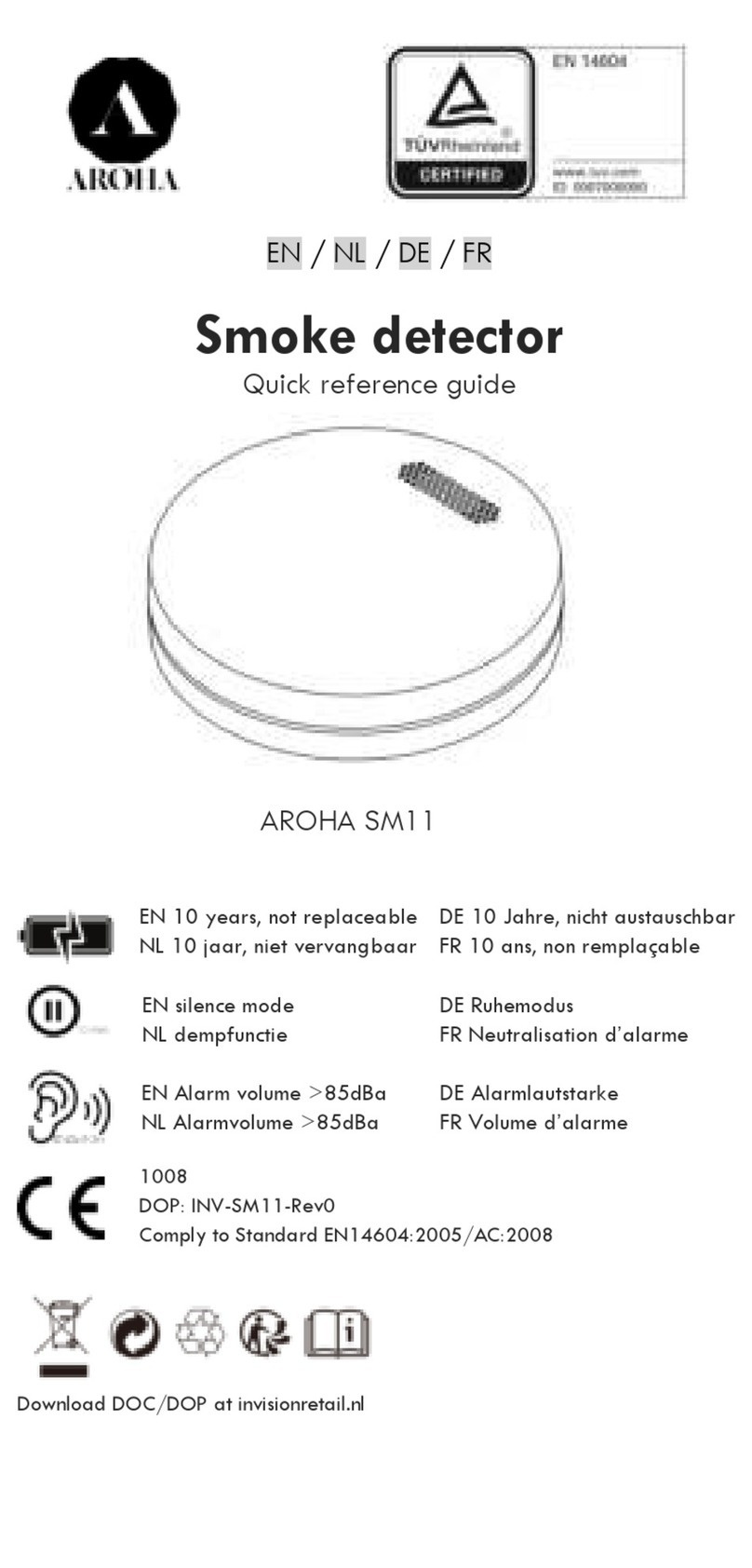
AROHA
AROHA SM11 Quick reference guide
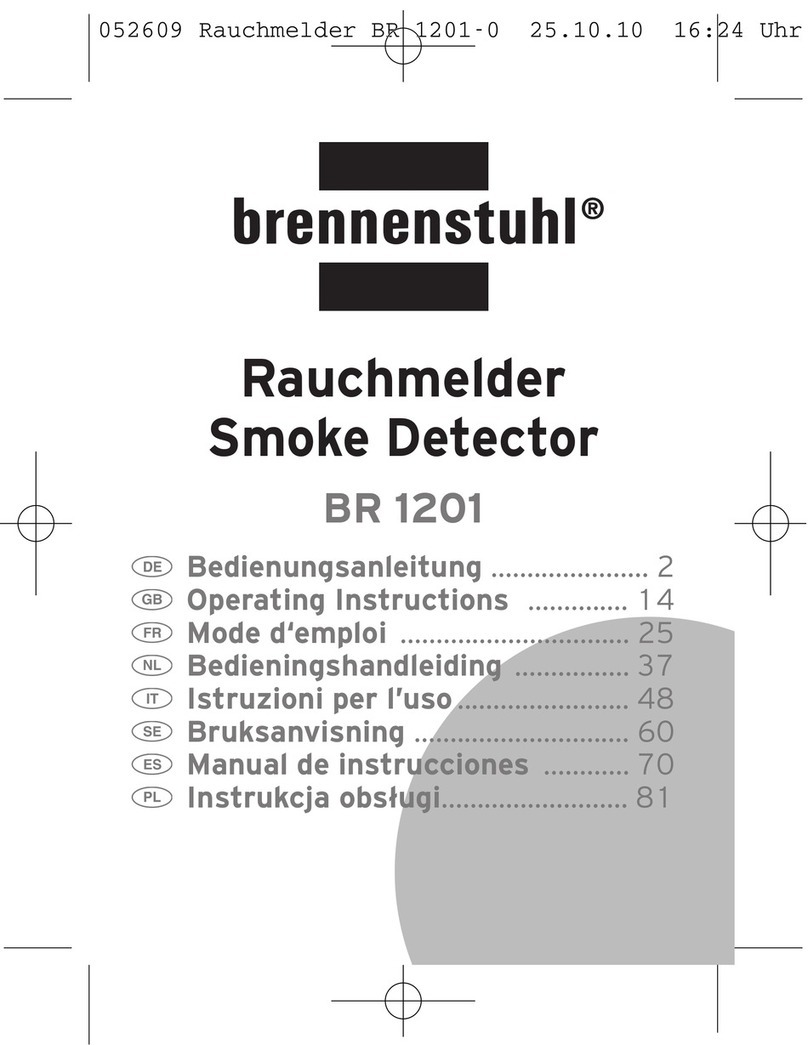
brennenstuhl
brennenstuhl BR 1201 operating instructions
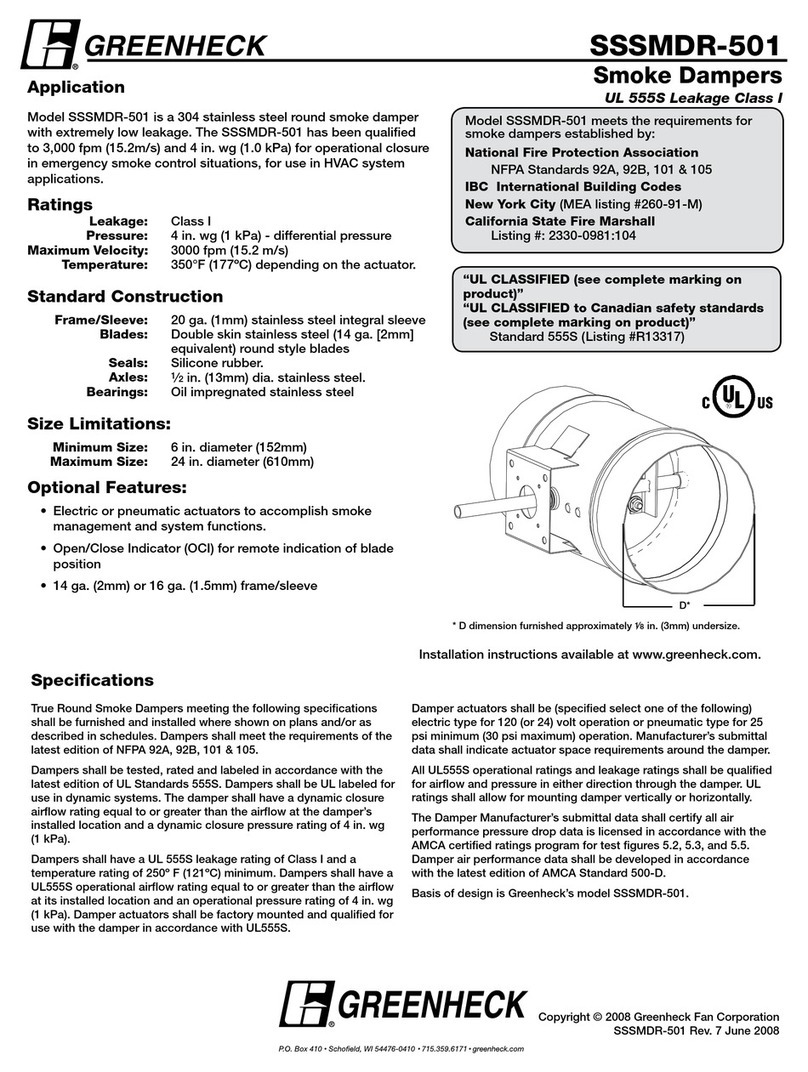
Greenheck
Greenheck Smoke Dampers SSSMDR-501 Specifications

S Fire
S Fire SF119 Series quick start guide

Weller
Weller LASERLINE 150 Translation of the original instructions
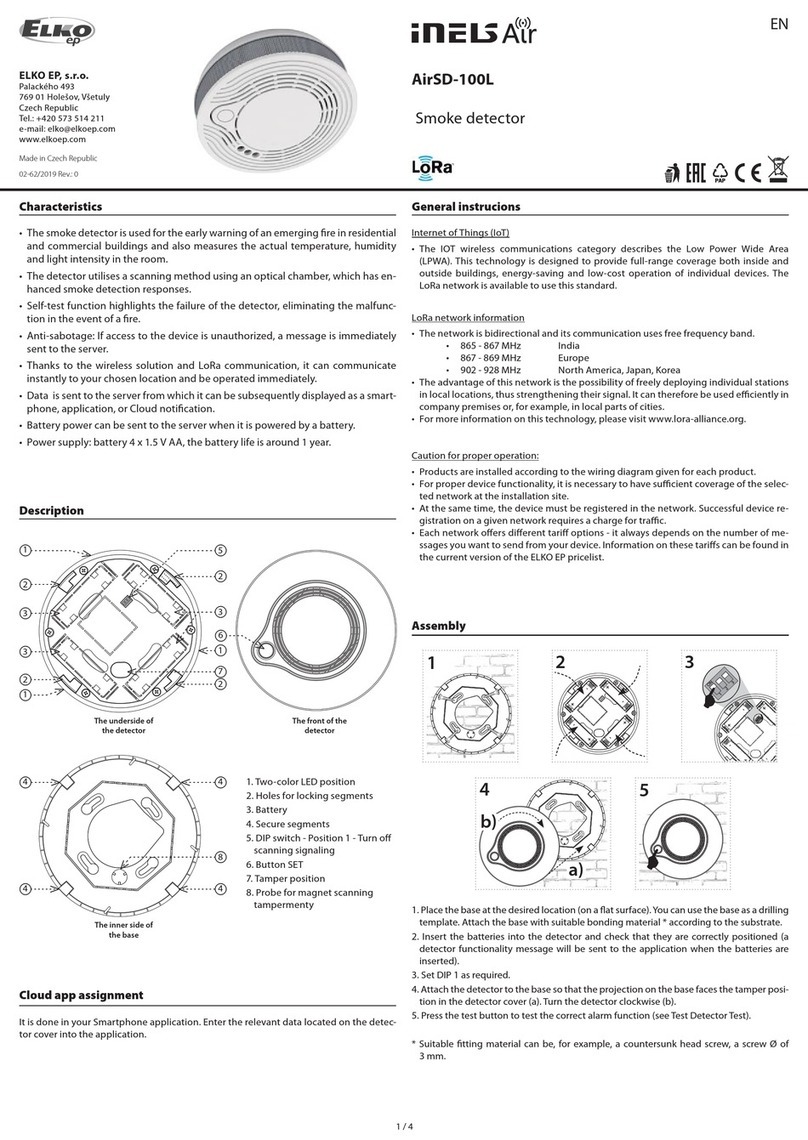
Elko
Elko iNELS Air AirSD-100L quick start guide
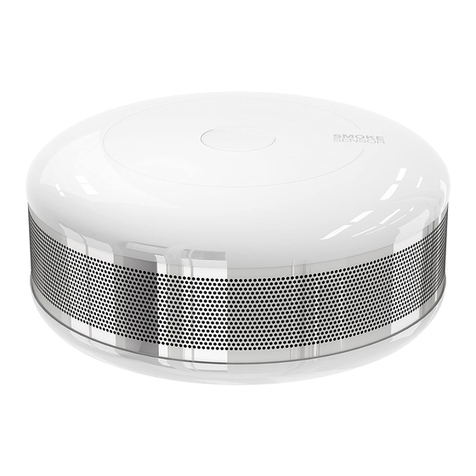
FIBARO
FIBARO FIBEFGSD-002 quick start guide

First Alert
First Alert Heat ALarm HD6135F user manual

ELRO
ELRO FS2010 user manual
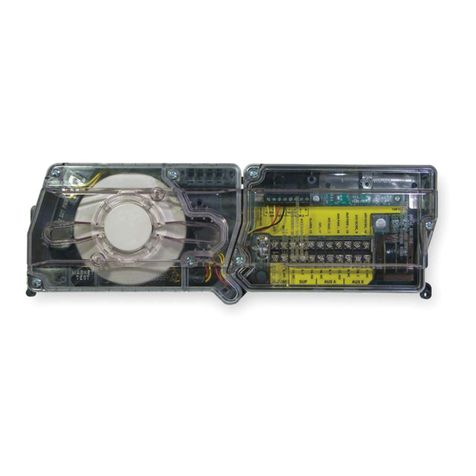
System Sensor
System Sensor Innovair flex D4120A Installation and maintenance instructions
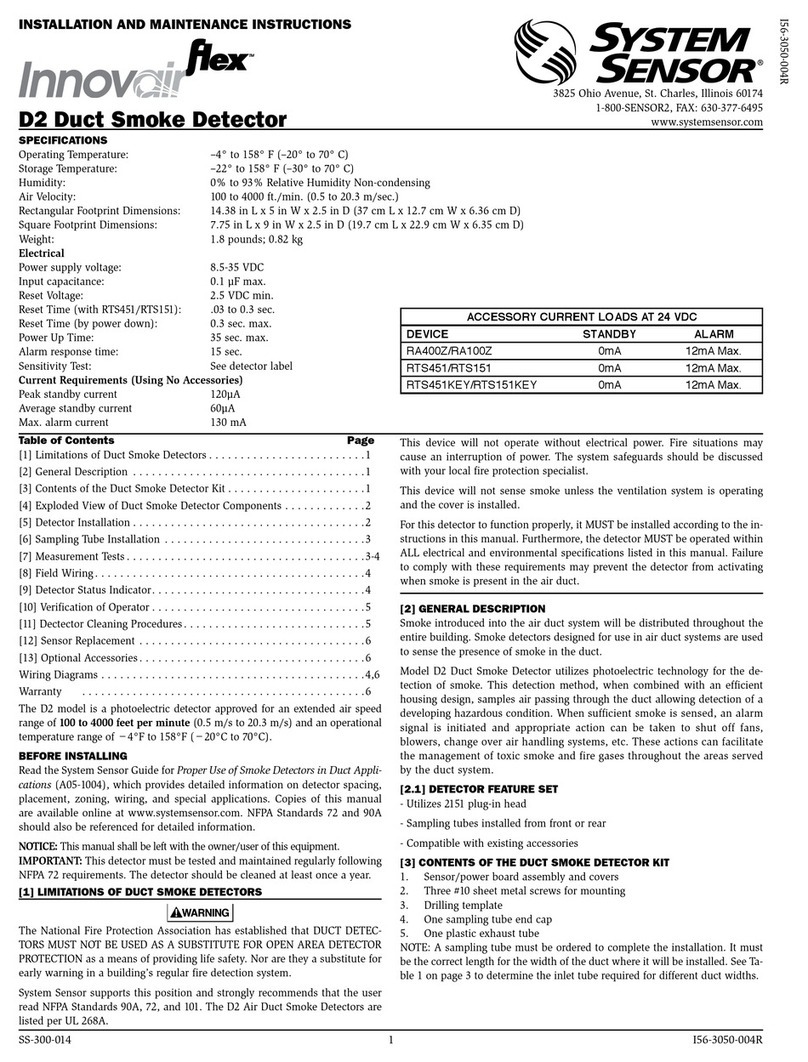
System Sensor
System Sensor Innovair flex D2 Installation and maintenance instructions
